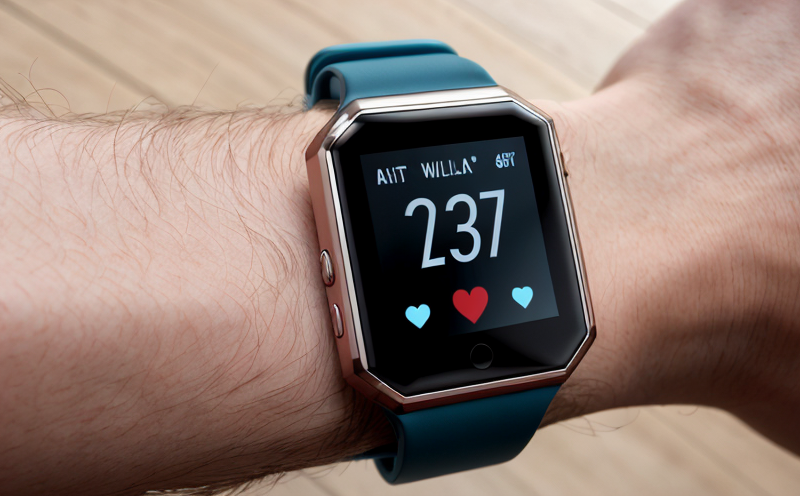ISO 18562-4 Leachables Testing from Breathing Pathway Wearables
The implementation of digital health devices and wearables in modern healthcare has brought unprecedented innovation. However, ensuring the safety and reliability of these devices is paramount. One critical aspect of this is leachable substance testing as specified by ISO 18562-4.
Leachables are compounds that can migrate from materials into a product or its environment during use. In the context of breathing pathway wearables, such as smart masks and ventilator interfaces, leachable substances could potentially pose risks to patient health if not properly controlled. This is where ISO 18562-4 comes into play.
The standard provides a framework for evaluating the potential leachates from medical devices in contact with biological fluids or respiratory gases. For breathing pathway wearables, this involves simulating real-world conditions to assess whether any materials could release harmful substances under typical use scenarios. The testing process is intricate and involves precise specimen preparation, rigorous extraction methods, and stringent analysis protocols.
The primary goal of ISO 18562-4 leachables testing is to ensure that the materials used in these devices do not introduce contaminants into the patient’s respiratory system. This includes assessing a wide range of potential leachable compounds such as metals, plasticizers, and other additives commonly found in medical device components.
Understanding the full scope of this testing requires an appreciation for both the technical intricacies involved and the broader implications for public health. By adhering to ISO 18562-4 standards, manufacturers can demonstrate compliance with regulatory requirements while also enhancing trust among healthcare providers and patients alike.
| Leachable Compound | Potential Source in Breathing Pathway Wearables | Risks if Released |
|---|---|---|
| Metallic elements (e.g., nickel) | Coatings on respiratory interfaces | Hypersensitivity reactions in patients |
| Plasticizers (phthalates) | Gasket materials or adhesives | Toxicity concerns leading to organ damage |
| Flame retardants | Insulation materials in ventilation systems | Potential neurotoxic effects |
The ISO 18562-4 protocol specifies a series of extraction procedures designed to mimic actual usage conditions. These include immersion tests where the breathing pathway component is exposed to physiological saline solution or respiratory gases for extended periods. After extraction, the leachates are analyzed using advanced analytical techniques like High Performance Liquid Chromatography (HPLC) and Inductively Coupled Plasma Mass Spectrometry (ICP-MS).
This comprehensive approach ensures that all potential sources of contamination are identified and quantified accurately. Compliance with these stringent standards not only protects patients but also enhances the reputation of the manufacturer by showcasing a commitment to quality and safety.
Why It Matters
The significance of ISO 18562-4 testing cannot be overstated, especially when dealing with devices that come into direct contact with respiratory pathways. Compliance with these standards is crucial for several reasons:
- Patient Safety: Ensures that no harmful substances are introduced into the patient's breathing environment.
- Regulatory Compliance: Helps manufacturers meet international regulatory requirements, thereby facilitating market access.
- Risk Management: Identifies and mitigates risks associated with material selection and manufacturing processes.
- Trust Building: Establishes confidence among healthcare providers and patients regarding the safety of the device.
Industry Applications
The application of ISO 18562-4 leachables testing extends across various sectors within medical devices, particularly those involving direct patient interaction. Below are some key areas where this testing is essential:
| Device Type | Potential Leachable Compounds |
|---|---|
| Smart Masks | Nickel, plasticizers, flame retardants |
| Mechanical Ventilators | Boron trifluoride esters, glycol ethers |
| Respiratory Filters | Silicones, organic solvents |
Eurolab Advantages
Eurolab offers unparalleled expertise in ISO 18562-4 leachables testing, providing comprehensive services tailored to the unique needs of breathing pathway wearables. Our advantages include:
- Experienced Staff: A team of experts with deep knowledge of medical device regulations and standards.
- Advanced Equipment: State-of-the-art analytical instruments capable of detecting even trace amounts of leachables.
- Comprehensive Reporting: Detailed reports that provide a clear understanding of test results and compliance status.
- Regulatory Guidance: Assistance with navigating complex regulatory landscapes and ensuring full compliance.





